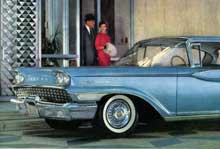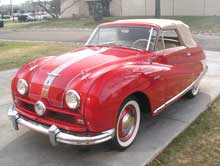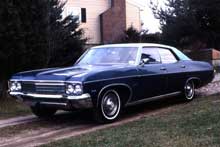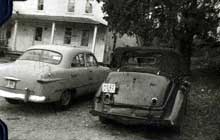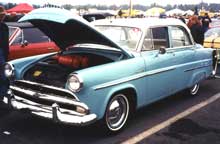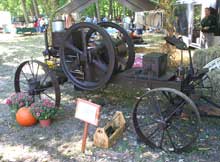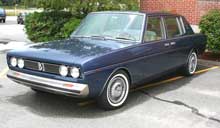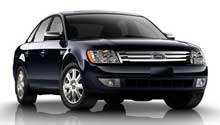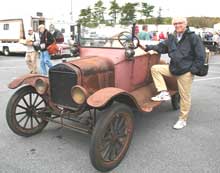You’re probably thinking “Edsel.” But while Ford’s “E-car” was an attempt to fill holes in FoMoCo’s product line, with models priced both above and below Mercury it was competing instead with Pontiac and Buick, a strategy that with hindsight seems incredibly foolhardy. Rather, it was Mercury itself that was Olds’s competition – the two cars had been priced opposite one another from Mercury’s birth in 1939. But Mercury had outsold Olds only one year, 1953, and then by fewer than 1,000 cars. For 1959, Ford decided to pull out all the stops and build a better Oldsmobile.
We generally think of the 1959 Mercury as an evolution of the 1957 and 1958 models. With ’57’s cove accents bulked up to rocket ship proportions, the ’59 appeared a bit bizarre. Actually, as the late Ford product planner Richard Stout explained in his book Make ‘Em Shout Hooray, the ’59 Merc was all new, “From Road to Roof” as the catalog put it. In four series, Monterey, Montclair, Park Lane, and Station Wagons, Mercury sold from $2,832 to $4,206. Wagons were all of pillarless hardtop design, both two- and four-door, a concept dating from ’57. Engines came in three sizes, 312, 383 and 430 cubic inches, and four stages of tune, 210, 280, 322 and 345 bhp.
All GM cars were new for ’59, a welcome relief from the excesses of 1958. Oldsmobile had three series, Dynamic 88, Super 88 and Ninety-Eight. Wagons, only in four-door “post” configuration, were offered in Dynamic and Super 88 trim. Prices ranged from $2,837 to $4,366. There were but two engines, 371 and 394 cid, and three stages of tune, 270, 300 and 315 bhp. The 1959 GM cars were distinctive with Panoramic windshields and wrap-around rear windows, but Mercury had its own version of these, a windshield reaching up into the roof and a rear light wrapped around to the rear doors. Interestingly, Merc gave this treatment only to sedans, while Olds reserved it for hardtops. Mercury had no counterpart to Olds’s Trans-Portable radio or Autronic Eye automatic headlight dimmer, but Merc’s parallel wipers cleared a much larger area than the Olds “clap-hands” arrangement.
Despite Oldsmobile’s X-braced “cow belly” frame, Mercury had more passenger room, larger door openings and greater luggage capacity. Ford had built a better Mercury, but the public was unconvinced that it was a better Oldsmobile. Ford outsold Chevy in 1959, but that popularity didn’t extend to the medium-price segment. When the totals were tallied, it was your father’s Oldsmobile, outselling Mercury by better than two to one.

